If the garage is not insulated, then it simply turns into a canopy from the rain. Although the car is not a person, negative temperatures in winter are also contraindicated for him. First you need to insulate the garage door, through which most of the heat goes out into the street. Here it is possible both to get rid of drafts with the help of seals on the doors, and more complex work with the installation of heat-insulating materials.
Why and how to insulate the garage
Inexperienced motorists do not attach much importance to the insulation of the garage. There is a garage for the car and it's already good. And soon they are surprised to find that the body of the car begins to rust. It's all about humidity. Cold outdoor air, penetrating through the gate without insulation, causes a temperature difference, which leads to condensation.
Qualitatively insulated garage doors - the key to the longevity of the car
Misting in the garage occurs both in winter and summer. Here, both the cooling engine and the change in temperature outside during the day have an influence. As a result, high humidity contributes to the development of mold, which affects the car itself and everything in the room with it. At first imperceptibly, but metal products, the body and electrical wiring begin to rust, and the interior trim cracks.
The second point is the garage itself. Car owners use it not only as a parking lot for cars, but also often equip a workshop, carpentry and just an interest club for friends in it. If the gates and walls of the garage are well insulated, then working inside will be much more comfortable. Repairing a car in the cold is still a pleasure.
Note! According to the standards, the temperature in the garage must be maintained at a level not lower than +5 0 C. This is enough for the engine to start without additional warming up, and the body does not rust.
In most cases, in the garage, the walls are made thick and reliable. The cold gets inside mainly through the gate, which must be carefully insulated. The task of such thermal insulation is to minimize the leakage of warm air through garage doors. A lot of heat comes from a cooling engine, you just need to prevent it from escaping into the street through the door holes.

If the garage is made of a profile, then the gates and walls will have to be insulated from the inside.
To minimize condensation, ventilation must be done in any room. But in the garage it is better to do with a simple hood with natural circulation. Moreover, it must be made so that it can be blocked. There is not too much heat anyway, there is no heating, air exchange during severe frosts should be reduced to a minimum.
Types of gates and features of their thermal insulation
There are several types of “doors” for entering a car garage. In some cases, it is easier to buy ready-made insulated garage doors, while in others you can make them warm with your own hands after installation. However, the desire to make something on your own is not always prudent. There are gate structures that are quite problematic to insulate with high quality.
The garage entrance can be closed with the following types of gates:
- swing;
- lifting and turning;
- sectional;
- rolled.
The swing design is the most common and consists of one or a pair of wings that open outward. These classic doors are in demand due to ease of installation, reliability and anti-vandal security. They are made of metal sheets 2-3 mm thick and reinforced with a corner. It is easier to make them and then insulate them with your own hands.

On the thermal imager, heat leakage through the garage door is clearly visible
In the lift-and-turn model, the sash rises to the ceiling. In most cases, these are products that are manufactured and insulated inside with various materials in the factory. These one-piece sandwich panels are made from two sheets of metal and polyurethane foam between them. It is not necessary to insulate them additionally, it is enough just to carry out the installation correctly according to the instructions and install the seals.
Sectional doors are an improved version of the overhead door. Only they do not consist of a single canvas, but of several horizontally connected sections, which, when opened, fold like an accordion or move along the guides to the ceiling.
Roller blinds are a descending/rising canvas, consisting of separate narrow plates, which, when closed, are wound on a shaft under the ceiling. Like the sectional version, rolling shutters already come with insulation inside the slats. If a structure without heat-insulating material is purchased, then it is difficult to insulate it on your own. It will be necessary to inject polyurethane foam into the sections.
Advice! If the garage is located in the northern regions, then it is better for him to choose swing gates. Only they can be well insulated with their own hands, creating acceptable conditions for storing cars inside.
Ready-made, already warm, industrial-made rolling and sectional doors are not able to keep heat in severe frosts. However, it is rather problematic to additionally produce their thermal insulation. For the southern regions, they are quite suitable, and in Siberia it is better to install a hinged insulated alternative.
What thermal insulation material to choose
Before you start insulating the gates in the garage with your own hands, you need to correctly select the thermal insulation. The assortment line of insulating materials is huge, but not all of them will fit for insulating an automobile “house”.
For independent thermal insulation of garage doors are suitable:
- Slab foam or polystyrene.
- Sprayed polyurethane foam or penoizol.
The latter option will give odds to the rest in terms of fire resistance, but it is much inferior to them in terms of moisture resistance. Mineral wool is cheaper, but with equal thermal conductivity, its layer will be thicker and heavier than that of expanded polystyrene and polyurethane foam.
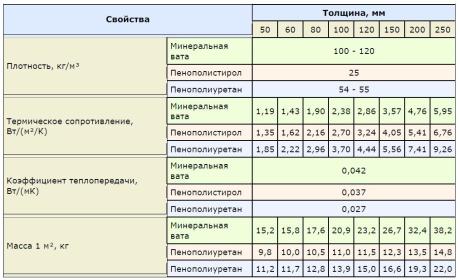
Comparative analysis of the most popular heaters
To insulate garage doors, it is best to take one of the varieties of mineral wool. This roll material is easier to mount, but the main thing is that it is not afraid of fire. The same cannot be said for foamed and sprayed polymer-based alternatives. They, despite all the impregnations and additives, still remain fire hazardous.
Advice! Due to its incombustibility, mineral wool is the best option for thermal insulation of a garage room. The less combustible and flammable materials used in the sheathing, the safer it is to leave the car in it.
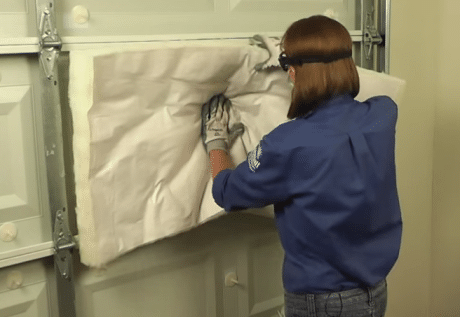
The main advantage of mineral wool over other heaters is incombustibility.
You can also use heat-insulating paint. To apply it, a regular brush is enough. After the thermal paint dries, a polymer-ceramic film with high thermal insulation characteristics is formed on the door leaf. But it will have to be applied to the gate in several layers, forming a coating of the desired thickness and insulating properties.
After the door is insulated, the temperature in the garage will no longer fluctuate constantly, which will reduce the risk of condensation. Most heaters are mounted on the front side of buildings. But it is impractical and simply unreasonable to insulate garage doors from the outside. It is not for nothing that they are made of durable iron, protection from vandals and thieves will not interfere with the car.
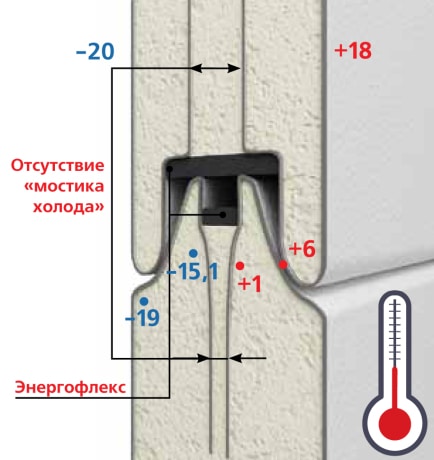
The sections are already filled with a heat insulator and do not have cold bridges, you just need to follow the rubber seals
If the insulation is fixed on the garage door from the outside, then it will not be possible to open it completely. The design of the swing doors will not allow them to be opened wide in this case, and the sectional models are simply not designed for such changes, they cannot even fold in half. Plus, the heat-insulating material from the outside can be set on fire. It remains only the option with installation from the inside.
How to insulate your garage door yourself
There are three methods for insulating garage doors:
- The use of sealants to close gaps.
- Installation of heat-insulating materials on the sash leaf.
- Hanging a curtain.
For thermal insulation of swing and up-and-over gates, all three methods can and should be used. And if a sectional or roll structure is installed at the entrance to the garage, then it will be possible to insulate it only with the help of the first and last trick.
Sealers - fight against drafts
No matter how accurately the gate is adjusted in size, gaps still inevitably appear. To eliminate drafts, the gaps between the wings, as well as at the points of their connection with the floor, ceiling and walls, should be closed with a sealant. It fills the gap and prevents the exit of warm air from the room.

To insulate rolling shutters, the sealant is glued inside the garage on the floor
The sealing insert can be:
- silicone;
- rubber;
- in the form of a nylon brush with wax impregnation.
Frost-resistant garage seals are available in the form of tubes and tapes with or without a self-adhesive backing. In the second case, you will need the appropriate glue to mount them. The brush version lasts the longest, but it also costs more.
Advice! The seals are mounted on the sashes, the gate frame or on the load-bearing structures along the perimeter of the sash. But it is much better when the sealing material is glued on both sides so that the inserts are in contact with each other.
It is not recommended to use polyurethane foam to seal gaps in garage doors. Of course, with its help you can create a reliable barrier to drafts. However, with constant closing / opening of the doors, the foam layer will quickly collapse. Yes, and in the open air, it begins to crumble. But as an option for one winter it is quite enough.
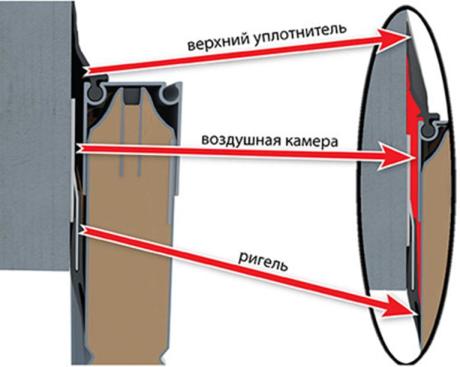
An air cushion is created between the two seals, which prevents heat from being drawn out of the garage.
In addition to factory products, a garage seal can be made from improvised means: a rubber hose or a piece of an automobile chamber. But the wear resistance of these options is obviously lower than the frost-resistant liners specially designed for this.
Insulation in garage doors - basic thermal insulation
Seals alone for high-quality thermal insulation of garage doors are rarely enough. Often you have to fully insulate the sash. At the same time, it is necessary to prepare their metal parts by cleaning them from rust and painting, and then sheathe everything on top with decorative panels or wood.

Scheme of installation of heat-insulating material in the door leaf of the garage
To insulate garage door leaves:
- Clean the rust on the metal of the door leaf, and then paint it for waterproofing with bituminous mastic.
- Fix a frame made of a bar with a section of 20–25 mm on the sashes with self-tapping screws.
- Fill the resulting honeycombs with insulation (foam polyurethane foam, cut and glue foam or insert cut-to-size mineral wool).
- Sheathe the OSB frame, clapboard or laminated MDF.
Wood boards for sheathing garage doors should only be used moisture resistant types. Ordinary fiberboard or plywood will swell and warp. It is better to take laminated sheets altogether. They cost more, but will last longer in a garage without heating.
On a note! The insulation fixed on the garage door can not be sheathed with wood. It is enough to close it with penofol or other dense foil material.
Sheathing with foil will additionally insulate the garage doors. Just fix it with a layer of aluminum inside, then the heat will be reflected back into the room. Not much, but even keeping that heat energy inside will help keep the humidity down.
Curtain - additional protection
As an addition to the warm gate at the entrance to the garage, you can hang a curtain to increase its thermal insulation. For it, it is necessary to stretch the rope or fix a steel pipe with a diameter of 15–20 mm instead. The main thing is that the curtain should be made of a dense material (tarpaulin or PVC).
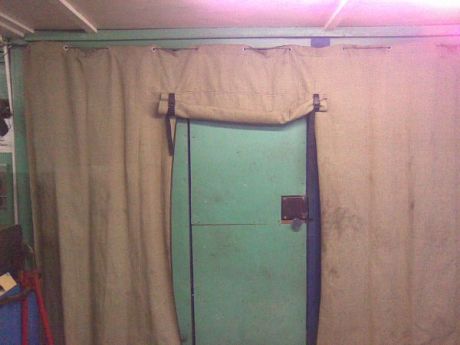
Tarpaulin panel well prevents heat leakage
Instead of a tarp, you can hang vertical strips of polyethylene. Similar protection is used in car washes and workshops. Extremely simple, but quite reliable - much less heat will escape from the garage room.
A selection of video lessons on the topic
Insulation technology for old garage doors:
How to seal gaps in garage doors:
Heated garage door lining:
Self-insulation of the entrance opening and garage doors should not cause difficulties. You should not consider this an excess, it is safer to store a car in a warm room without condensation, rust will not touch it. To do this, it is enough to insulate the garage doors with foam or mineral wool, and also close the gaps with a rubber or silicone sealant. And as an additional barrier to cold air, you can hang a canvas curtain.



